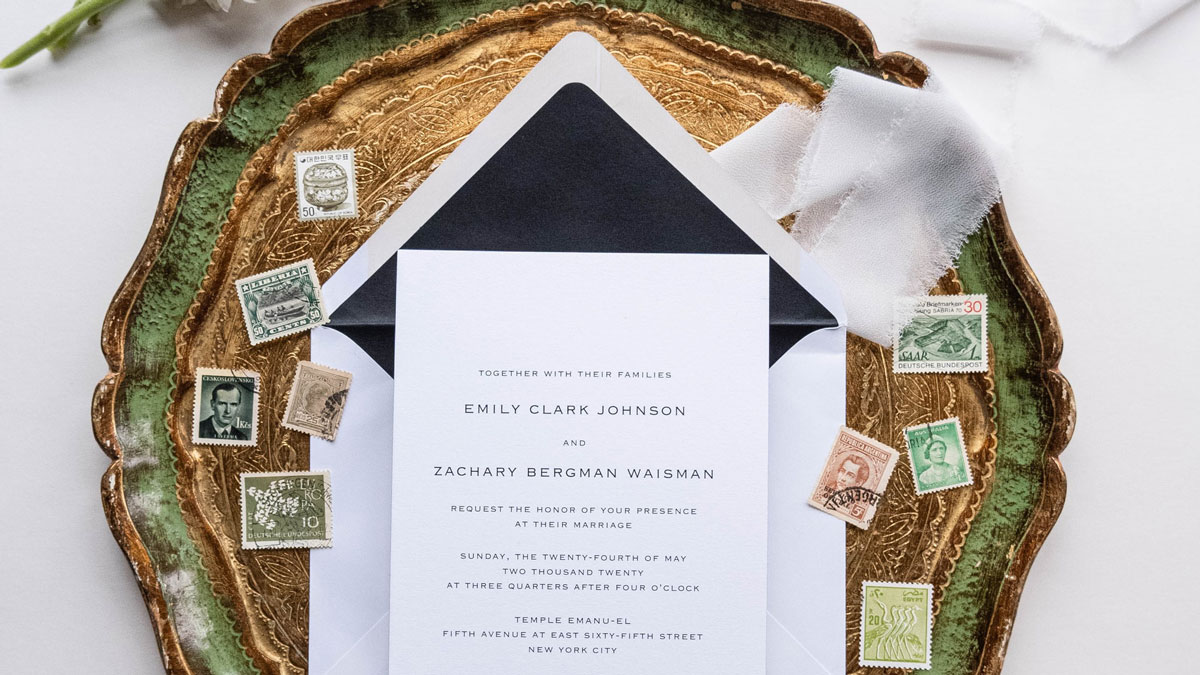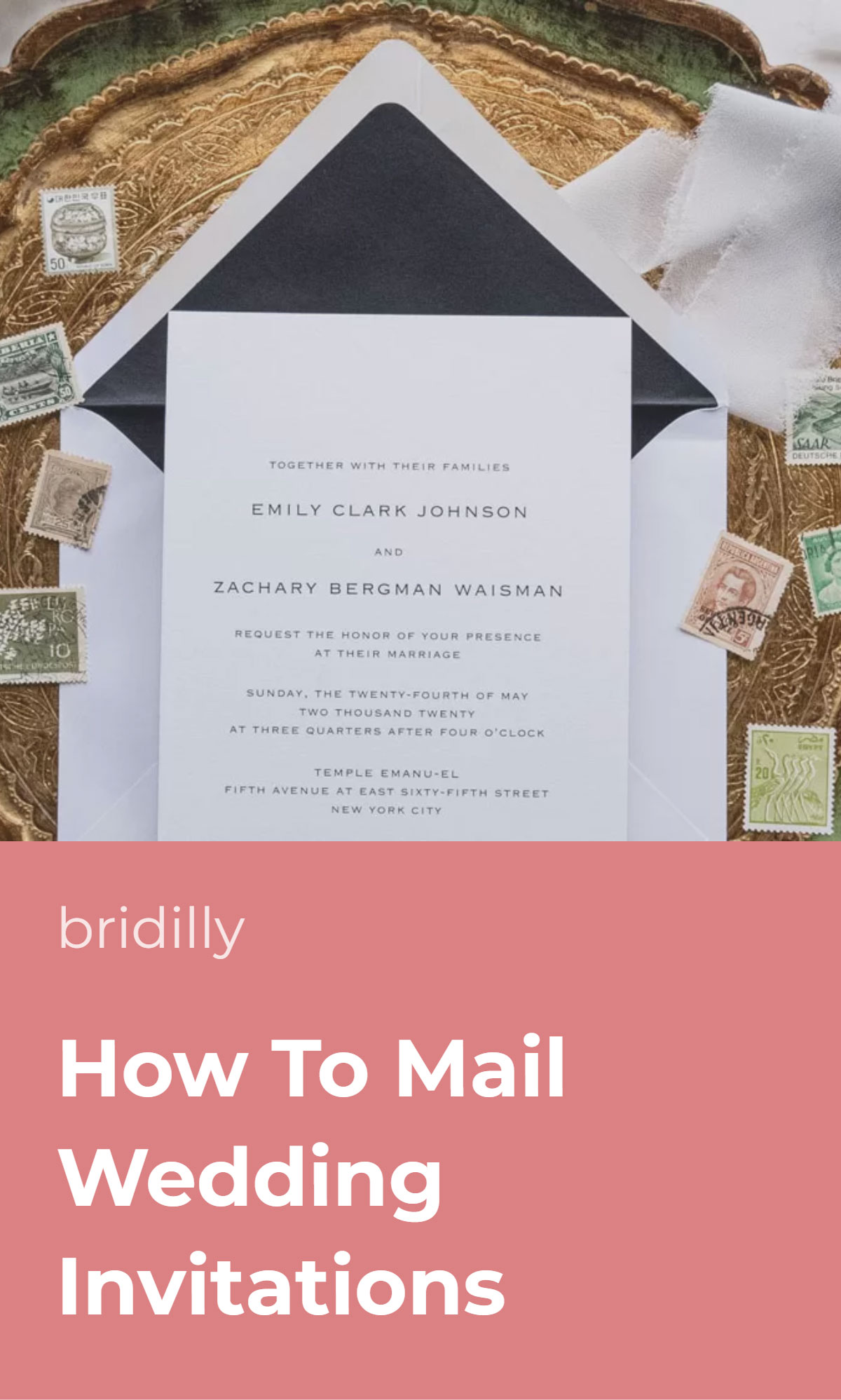Every couple should know how to mail wedding invitations the right way to avoid them being damaged, lost, or returned.
Mailing your invitations may seem straightforward, but it has numerous pitfalls most people neglect until it’s too late.
Wedding invitations offer plenty of room for personalization, but you should also follow the etiquette and mailing rules.
From determining the wedding invitation mailing timeline to addressing them and choosing the proper stamps, there are numerous points to keep in mind to ensure your invitations arrive at the recipients.
However, don’t stress it – your guests will undoubtedly receive their invitations if you do everything on time, buy the correct stamps, and double-check the envelope information.
Table of Contents [show]
When to Mail Invitations
As a rule of thumb, send your wedding invitations about six to eight weeks before the wedding. However, if some of your guests live far away or abroad, you may send the invitations about 12 weeks in advance.
Many couples send save-the-dates before the actual invitations, about four to six months before the wedding.
It’s a great option if you want to give your guests a heads up but aren’t yet sure about the exact event time and location.
Of course, you can adjust the timeline to your specific case, but don’t send the invitations too early. You likely won’t receive RSVPs earlier because guests can’t plan too long in advance, but it will limit your flexibility.
Sending invitations late is also risky because the post isn’t the fastest way to deliver information.
Your invitations may get delayed, lost, or sent back due to address mistakes. You can send the invitations first-class to ensure they arrive on time.
Envelope or No Envelope?
Traditionally, wedding invitations come with two envelopes – a formal outer envelope for the mailperson and an inner envelope addressed informally to the recipient.
Typically, the outer envelope includes the recipient’s full name and address, whereas the inner envelope has their short name and spouse and kids’ names.
However, some couples ditch the inner envelopes to save money or consider using so much paper wasteful.
There’s nothing wrong with refraining from the inner envelope, although it adds formality to the invitations. You have numerous ways to include all the necessary information on a single paper card.
On the other hand, the outer envelope is mandatory for the mail and can’t be ditched. Most couples pick an outer envelope that matches the invitation design. However, an ordinary white envelope will do the job if you’re on a budget.
Mail or Email?
Sending wedding invitations by mail is a long-standing tradition. Unpacking a beautifully designed, double-envelope invitation creates a celebratory, formal sense. However, many couples nowadays choose to send their invitations by email.
You may wonder – is it ok to send wedding invitations by email? Won’t it be seen as tacky or rude? Email invitations have numerous benefits, so embracing technology is perfectly alright.
Email wedding invitations are cheaper, have a smaller carbon footprint, and won’t get lost along the way unless they get into the spam folder.
If you’re concerned that your older wedding guests won’t like email invitations or don’t even have an email address, you can make traditional paper invitations for them and send the rest by email.
Information to Include
Wedding invitations are a vital element of your wedding theme, but they don’t serve a solely decorative purpose. Their primary purpose is informative, so you should know what to include in wedding invitations.
In the case of a classic wedding invitation with two envelopes, the primary invitation card typically includes the couple’s names, the occasion, the date, time, and location.
Sometimes, couples include other essential reception information on the invitation cards, such as venue directions, dress code, reception type, and theme. However, many mention this information on separate reception cards.
Apart from the invitation and reception cards, a traditional wedding invitation envelope also contains an RSVP and a response card.
RSVP is necessary to confirm that a guest will attend the wedding and mention their meal choices, allergies, and other crucial information.
The inner envelope can include the guest’s family members’ names to specify who’s invited.
However, this can also be mentioned on the invitation card, so you are free to skip the inner envelope. The outer envelope is necessary solely for the address.
The first line on the outer envelope is the recipient’s name, then their street address, city, state, ZIP code, and country.
You should write the recipient’s data in the envelope’s center. The return address should be written in the upper left corner of the envelope.
Double-check all information on the invitations before mailing them, especially the recipient addresses.
Proofreading isn’t fun, but it’s essential for your peace of mind. You don’t want to get the invitations back and lose time and money mailing them again.
Don’t use calligraphic fonts that are impossible to read on outer envelopes. Even if you admire unusual fonts, leave them for the inner envelope and the invitation card.
All information on the outer envelope should be readable. The USPS prefers sans-serif fonts that don’t have small lines at the end of characters.
Examples of sans serif fonts to use for wedding invitations include Helvetica, Arial, Geneva, and Avant-Garde.
Tissue Paper Inserts
Many couples think that tissue paper inserts in wedding invitations are only necessary for the looks, but they serve a practical purpose. Tissue paper prevents ink from smudging, which is vital for handwritten invitations.
The smudging problem is also common with thermography. However, if you opt for standard printed invitations, tissue paper is unnecessary.
Use Strong Adhesive
Mail workers don’t always handle invitations carefully. Even if they do their best, your invitations may open en route or get otherwise damaged.
The outer envelope is meant to protect the invitation, but you should close it properly.
Don’t lick your invitation outer envelopes even if they have an adhesive seal – this isn’t a reliable closure method.
Instead, use strong glue. You may also use a pretty sticker or decorative tape for extra protection and personalization.
Choose Hand Canceling
You likely want your invitations to arrive at the recipients’ clean and nice, so request hand canceling at the post office. Typically, the mail is canceled by machines that print lines and dates over postage stamps.
However, machines can rip, bend, or stain an invitation. In the case of wedding invitation hand canceling, a mail worker marks each envelope manually, preventing damage.
Simply bring your invitations to the post office and request hand canceling.
Some post offices will charge you an extra fee for hand canceling; others will agree to do it for free if they aren’t busy. Hand canceling isn’t the cheapest way to mail wedding invitations, but it’s always worth it.
You may even ask to hand-cancel your envelopes yourself to ensure everything goes smoothly, but some post offices will refuse to give you the stamp.
Another wedding invitation mailing tip is to always take your envelopes inside a post office instead of dropping them in a street mailbox. The envelopes can easily get damaged in a mailbox or transit.
Have the Invitations Weighed at the Post Office
The easiest way to determine which stamps your wedding invitations need is to bring one to your local post office and have it weighed.
Fully assemble the invitation, including all seemingly minor inserts such as tissue paper, and ask a postal clerk to weigh it. They will typically do it for free and advise on the necessary stamp type and number.
Choosing the Stamp
Some wedding invitations can be posted with regular stamps like letters. However, traditional invitations consisting of two envelopes, the invitation card, reception card, RSVP, and tissue paper can be heavy and bulky.
Furthermore, many couples choose non-standard invitation formats, for example, a square. Heavy and oddly shaped invitations may require extra postage – that’s why weighing your invitations at the post office is essential.
The recipient location and preferred delivery times also play a role. Postage is always more expensive for mailings outside of the U.S.
Similarly, if you want mail workers to prioritize your invitation delivery, expect to pay more for postage.
A standard first-class stamp for mailings under an ounce costs about $0.58, while for mailings up to two ounces – $0.78. Although $0.20 doesn’t seem like a big difference, it leads to an extra $20 for 100 invitations.
If your invitations have an unusual shape, wax seals, or other non-standard elements, expect to pay over $0.88 for a single stamp.
You may save some money by purchasing stamps online in bulk. However, you risk getting the wrong type. Visiting a post office in person and buying stamps there is better because it gives you peace of mind.
Lastly, consider the stamp design. The USPS has dozens of forever stamp designs to add a personal touch to your envelopes.
Stamp Also the Response Card Envelopes
The wedding invitation mailing etiquette states that you should also pay for the RSVP response card postage. Therefore, you should send them in envelopes and stamp each envelope.
Mention your address on the response card envelopes, and don’t forget to proofread it to ensure you receive the cards.
This way, mailing the response cards will be easier for the guests, and you’ll be sure that the address is accurate.













No Comments Add one
Leave a Comment